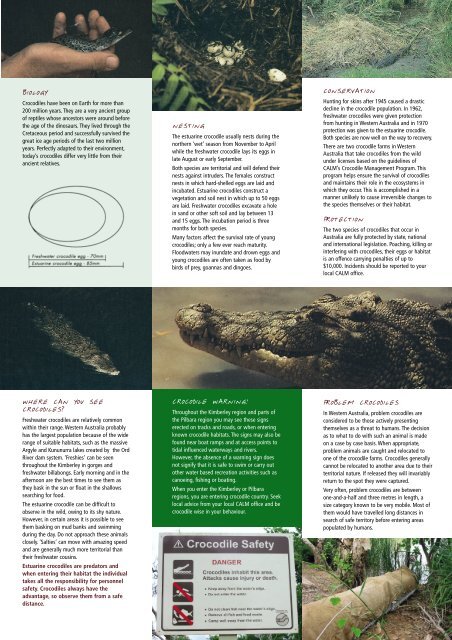2004109 Crocodile Brochure - Department of Environment and ...
2004109 Crocodile Brochure - Department of Environment and ...
2004109 Crocodile Brochure - Department of Environment and ...
You also want an ePaper? Increase the reach of your titles
YUMPU automatically turns print PDFs into web optimized ePapers that Google loves.
BIOLOGY<strong>Crocodile</strong>s have been on Earth for more than200 million years. They are a very ancient group<strong>of</strong> reptiles whose ancestors were around beforethe age <strong>of</strong> the dinosaurs. They lived through theCretaceous period <strong>and</strong> successfully survived thegreat ice age periods <strong>of</strong> the last two millionyears. Perfectly adapted to their environment,today’s crocodiles differ very little from theirancient relatives.NESTINGThe estuarine crocodile usually nests during thenorthern ‘wet’ season from November to Aprilwhile the freshwater crocodile lays its eggs inlate August or early September.Both species are territorial <strong>and</strong> will defend theirnests against intruders. The females constructnests in which hard-shelled eggs are laid <strong>and</strong>incubated. Estuarine crocodiles construct avegetation <strong>and</strong> soil nest in which up to 50 eggsare laid. Freshwater crocodiles excavate a holein s<strong>and</strong> or other s<strong>of</strong>t soil <strong>and</strong> lay between 13<strong>and</strong> 15 eggs. The incubation period is threemonths for both species.Many factors affect the survival rate <strong>of</strong> youngcrocodiles; only a few ever reach maturity.Floodwaters may inundate <strong>and</strong> drown eggs <strong>and</strong>young crocodiles are <strong>of</strong>ten taken as food bybirds <strong>of</strong> prey, goannas <strong>and</strong> dingoes.CONSERVATIONHunting for skins after 1945 caused a drasticdecline in the crocodile population. In 1962,freshwater crocodiles were given protectionfrom hunting in Western Australia <strong>and</strong> in 1970protection was given to the estuarine crocodile.Both species are now well on the way to recovery.There are two crocodile farms in WesternAustralia that take crocodiles from the wildunder licenses based on the guidelines <strong>of</strong>CALM’s <strong>Crocodile</strong> Management Program. Thisprogram helps ensure the survival <strong>of</strong> crocodiles<strong>and</strong> maintains their role in the ecosystems inwhich they occur. This is accomplished in amanner unlikely to cause irreversible changes tothe species themselves or their habitat.PROTECTIONThe two species <strong>of</strong> crocodiles that occur inAustralia are fully protected by state, national<strong>and</strong> international legislation. Poaching, killing orinterfering with crocodiles, their eggs or habitatis an <strong>of</strong>fence carrying penalties <strong>of</strong> up to$10,000. Incidents should be reported to yourlocal CALM <strong>of</strong>fice.WHERE CAN YOU SEECROCODILES?Freshwater crocodiles are relatively commonwithin their range. Western Australia probablyhas the largest population because <strong>of</strong> the widerange <strong>of</strong> suitable habitats, such as the massiveArgyle <strong>and</strong> Kununurra lakes created by the OrdRiver dam system. ‘Freshies’ can be seenthroughout the Kimberley in gorges <strong>and</strong>freshwater billabongs. Early morning <strong>and</strong> in theafternoon are the best times to see them asthey bask in the sun or float in the shallowssearching for food.The estuarine crocodile can be difficult toobserve in the wild, owing to its shy nature.However, in certain areas it is possible to seethem basking on mud banks <strong>and</strong> swimmingduring the day. Do not approach these animalsclosely. ‘Salties’ can move with amazing speed<strong>and</strong> are generally much more territorial thantheir freshwater cousins.Estuarine crocodiles are predators <strong>and</strong>when entering their habitat the individualtakes all the responsibility for personnelsafety. <strong>Crocodile</strong>s always have theadvantage, so observe them from a safedistance.CROCODILE WARNING!Throughout the Kimberley region <strong>and</strong> parts <strong>of</strong>the Pilbara region you may see these signserected on tracks <strong>and</strong> roads, or when enteringknown crocodile habitats. The signs may also befound near boat ramps <strong>and</strong> at access points totidal influenced waterways <strong>and</strong> rivers.However, the absence <strong>of</strong> a warning sign doesnot signify that it is safe to swim or carry outother water based recreation activities such ascanoeing, fishing or boating.When you enter the Kimberley or Pilbararegions, you are entering crocodile country. Seeklocal advice from your local CALM <strong>of</strong>fice <strong>and</strong> becrocodile wise in your behaviour.PROBLEM CROCODILESIn Western Australia, problem crocodiles areconsidered to be those actively presentingthemselves as a threat to humans. The decisionas to what to do with such an animal is madeon a case by case basis. When appropriate,problem animals are caught <strong>and</strong> relocated toone <strong>of</strong> the crocodile farms. <strong>Crocodile</strong>s generallycannot be relocated to another area due to theirterritorial nature. If released they will invariablyreturn to the spot they were captured.Very <strong>of</strong>ten, problem crocodiles are betweenone-<strong>and</strong>-a-half <strong>and</strong> three metres in length, asize category known to be very mobile. Most <strong>of</strong>them would have travelled long distances insearch <strong>of</strong> safe territory before entering areaspopulated by humans.
















